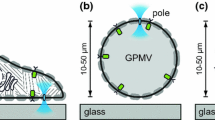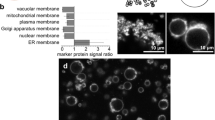Abstract
A model of membrane potential-dependent distribution of oxonol VI to estimate the electrical potential difference Δψ across Schizosaccharomyces pombe plasma membrane vesicles (PMV) has been developed. Δψ was generated by the H+-ATPase reconstituted in the PMV. The model treatment was necessary since the usual calibration of the dye fluorescence changes by diffusion potentials (K+ + valinomycin) failed. The model allows for fitting of fluorescence changes at different vesicle and dye concentrations, yielding Δψ in ATP-energized PMV of 80 mV. The described model treatment to estimate Δψ may be applicable for other reconstituted membrane systems.
Similar content being viewed by others
REFERENCES
Apell, H.-J., and Bersch, B. (1987). “Oxonol VI as an optical indicator for membrane potentials in lipid vesicles,” Biochim. Biophys. Acta 903, 480–494.
Bashford, C. L., and Smith, J. C. (1979). “The use of optical probes to monitor membrane potential,” Methods Enzymol. 55, 569–586.
Bashford, C. L., Chance, B., and Smith, J. C. (1979). “The behavior of oxonol dyes in phospholipid dispersions,” Biophys. J. 25, 63–85.
Beeler, T. J., Farmen, R. H., and Martonosi, A. N. (1981). “The mechanism of voltage-sensitive dye responses on sarcoplasmatic reticulum,” J. Membr. Biol. 62, 3–137.
Cooper, C. E., Bruce, D., and Nicolls, P. (1990). “Use of oxonol V as a probe of membrane potential in proteoliposomes containing cytochrome oxidase in the submitochondrial orientation,” Biochem. 29, 3859–3865.
Gläser, H.-U., and Höfer, M. (1987). “Ion-dependent generation of the electrochemical proton gradient ΔμH + in reconstituted plasma membrane vesicles from the yeast Metschnikowia reukaufii,” Biochim. Biophys. Acta 905, 287–294.
Höfer, M., Mair, T., and Wernsdörfer, E. (1991). “Molecular biology and biotechnology,” In: Yeast (Prasad, R. ed.), Omega Scientific Publishers, New Delhi, pp. 239–253.
Kletterer, B., Neumcke, B., and Läuger, P. (1971). “Transport mechanism of hydrophobic ions through lipid bilayer membranes,” J. Membr. Biol. 5, 225–245.
Mair, T., and Höfer, M. (1988). “ATP-induced generation of pH-gradient and/or membrane potential in reconstituted plasma membrane vesicles from Schizosaccharomyces pombe,” Biochem. Int. 17, 593–604.
Perlin, D. S., Kasamo, K., Brooker, R. J., and Slayman, C. W. (1984). “Electrogenic H+ translocation by the plasma membrane ATPase of Neurospora,” J. Biol. Chem. 259, 7884–7892.
Plášek, J., and Sígler, K. (1995). “Slow fluorescent indicators of membrane potential: a survey of different approaches to probe response analysis,” J. Photochem. Photobiol. in press.
Pratap, P. R., Novak, T. S., and Freedman, J. C. (1990). “Two mechanisms by which fluorescent oxonols indicate membrane potential in human red blood cells,” Biophys. J. 57, 835–849.
Scherman, D., and Henry, J. P. (1980). “Oxonol V as a probe of chromaffin granule membrane potentials,” Biochim. Biophys. Acta 599, 150–166.
Smith, J. C. (1990). “Potential-sensitive molecular probes in membranes of bioenergetic relevance,” Biochim. Biophys. Acta 1016, 1–28.
Smith, J. C., Hallidy, L., and Topp, M. R. (1981). “The behavior of the fluorescence lifetime and polarization of oxonol potential-sensitive extrinsic probes in solution and in beef heart submitochondrial particles,” J. Membr. Biol. 60, 173–185.
Villalobo, A. (1990). “Reconstitution of ion-motive transport ATPases in artificial lipid membranes,” Biochim. Biophys. Acta 1017, 1–48.
Wolk, U., and Höfer, M. (1987). “Interactions between cyanine dyes and yeast cells: do cyanine dyes act as membrane potential sensitive probes?” Biochem. Int. 14, 501–509.
Zwolinsky, B. J., Eyring, H., and Reese, C. (1949). “Diffusion and membrane permeability,” J. Phys. Colloid Chem. 53, 1426–1453.
Author information
Authors and Affiliations
Rights and permissions
About this article
Cite this article
Portele, A., Lenz, J. & Höofer, M. Estimation of Membrane Potential Δψ in Reconstituted Plasma Membrane Vesicles Using a Numerical Model of Oxonol VI Distribution. J Bioenerg Biomembr 29, 603–609 (1997). https://doi.org/10.1023/A:1022439203461
Issue Date:
DOI: https://doi.org/10.1023/A:1022439203461




